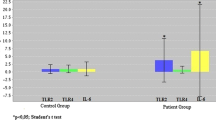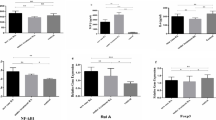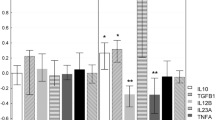Abstract
The Fc receptor-like (FCRL) molecules have recently been shown to contribute to the pathogenesis of certain autoimmune disorders. In this study, we investigated the expression levels of FCRL1, 2 and 4 in blood mononuclear cells from rheumatoid arthritis patients using real-time PCR. The mRNA of these molecules was detected in 44.4 % (FCRL1), 53.3 % (FCRL2) and 31.1 % (FCRL4) of patients. Comparatively, 31.1 % (FCRL1), 51.1 % (FCRL2) and 26.6 % (FCRL4) of controls expressed these genes. Analysis of gene expressions in FCRL-positive patients demonstrated a lower FCRL4 gene expression in patients compared to controls (P < 0.001). In FCRL2-positive patients, a significant positive correlation between FCRL2 expression and the erythrocyte sedimentation rate (P < 0.001), anti-cyclic citrullinated peptide antibody (P = 0.033) level and disease activity score (DAS28, P = 0.016) was found. In conclusion, decreased FCRL4 expression and association of FCRL2 expression with inflammatory markers and disease activity suggested the contribution of these molecules to RA inflammatory processes.



Similar content being viewed by others
References
Gibofsky A (2012) Overview of epidemiology, pathophysiology, and diagnosis of rheumatoid arthritis. Am J Manag Care 18(13 Suppl):S295–S302
Imboden JB (2009) The immunopathogenesis of rheumatoid arthritis. Annu Rev Pathol 4:417–434
Golmoghaddam H, Amirghofran Z, Aflaki E, Kamali-Sarvestani E, Shabani M, Esmaeilbeig M, Rajabi M (2013) Association of FCRL3 genotypes with susceptibility of Iranian patients to rheumatoid arthritis. Immunol Invest 42:296–306
Moura RA, Graca L, Fonseca JE (2012) To B or not to B the conductor of rheumatoid arthritis orchestra. Clin Rev Allergy Immunol 43:281–291
Díaz-González JF, Amaro IF (2007) The B cell in the pathogenesis of rheumatoid arthritis. Reumatol Clin 3:176–182
Tak PP, Rigby WF, Rubbert-Roth A, Peterfy CG, van Vollenhoven RF, Stohl W, Hessey E, Chen A, Tyrrell H, Shaw TM (2011) Inhibition of joint damage and improved clinical outcomes with rituximab plus methotrexate in early active rheumatoid arthritis: the IMAGE trial. Ann Rheum Dis 70:39–46
Keystone E, Emery P, Peterfy CG, Tak PP, Cohen S, Genovese MC, Dougados M, Burmester GR, Greenwald M, Kvien TK, Williams S, Hagerty D, Cravets MW, Shaw T (2009) Rituximab inhibits structural joint damage in patients with rheumatoid arthritis with an inadequate response to tumour necrosis factor inhibitor therapies. Ann Rheum Dis 68:216–221
Davis RS, Wang YH, Kubagawa H, Cooper MD (2001) Identification of a family of Fc receptor homologs with preferential B cell expression. Proc Natl Acad Sci U S A 14(98):9772–9777
Hatzivassiliou G, Miller I, Takizawa J, Palanisamy N, Rao PH, Iida S, Tagawa S, Taniwaki M, Russo J, Neri A, Cattoretti G, Clynes R, Mendelsohn C, Chaganti RS, Dalla-Favera R (2001) IRTA1 and IRTA2, novel immunoglobulin superfamily receptors expressed in B cells and involved in chromosome 1q21 abnormalities in B cell malignancy. Immunity 14:277–289
Davis RS (2007) Fc receptor-like molecules. Annu Rev Immunol 25:525–560
Maltais LJ, Lovering RC, Taranin AV, Colonna M, Ravetch JV, Dalla-Favera R, Burrows PD, Cooper MD, Davis RS (2006) New nomenclature for Fc receptor-like molecules. Nat Immunol 7:431–432
Davis RS, Dennis G Jr, Odom MR, Gibson AW, Kimberly RP, Burrows PD, Cooper MD (2002) Fc receptor homologs: newest members of a remarkably diverse Fc receptor gene family. Immunol Rev 190:123–136
Mechetina LV, Najakshin AM, Volkova OY, Guselnikov SV, Faizulin RZ, Alabyev BY, Chikaev NA, Vinogradova MS, Taranin AV (2002) FCRL, a novel member of the leukocyte Fc receptor family possesses unique structural features. Eur J Immunol 32:87–96
Masir N, Jones M, Pozzobon M, Marafioti T, Volkova OY, Mechetina LV, Hansmann ML, Natkunam Y, Taranin AV, Mason DY (2004) Expression pattern of FCRL (FREB, FcRX) in normal and neoplastic human B cells. Br J Haematol 127:335–343
Kazemi T, Asgarian-Omran H, Memarian A, Shabani M, Sharifian RA, Vossough P, Ansaripour B, Rabbani H, Shokri F (2009) Low representation of Fc receptor-like 1–5 molecules in leukemic cells from Iranian patients with acute lymphoblastic leukemia. Cancer Immunol Immunother 58:989–996
Kazemi T, Asgarian-Omran H, Hojjat-Farsangi M, Shabani M, Memarian A, Sharifian RA, Razavi SM, Jeddi-Tehrani M, Rabbani H, Shokri F (2008) Fc receptor-like 1–5 molecules are similarly expressed in progressive and indolent clinical subtypes of B-cell chronic lymphocytic leukemia. Int J Cancer 1:2113–2119
Wang K, Pei H, Huang B, Yang R-L, Wu H-Y, Zhu X, Zhu L (2012) Overexpression of Fc receptor-like 1 associated with B-cell activation during hepatitis B virus infection. Braz J Med Biol Res 45:1112–1118
Kochi Y, Yamada R, Suzuki A, Harley JB, Shirasawa S, Sawada T, Bae SC, Tokuhiro S, Chang X, Sekine A, Takahashi A, Tsunoda T, Ohnishi Y, Kaufman KM, Kang CP, Kang C, Otsubo S, Yumura W, Mimori A, Koike T, Nakamura Y, Sasazuki T, Yamamoto K (2005) A functional variant in FCRL3, encoding Fc receptor-like 3, is associated with rheumatoid arthritis and several autoimmunities. Nat Genet 37:478–485
Ikari K, Momohara S, Nakamura T, Hara M, Yamanaka H, Tomatsu T, Kamatani N (2006) Supportive evidence for a genetic association of the FCRL3 promoter polymorphism with rheumatoid arthritis. Ann Rheum Dis 65:671–673
Matesanz F, Fernández O, Milne RL, Fedetz M, Leyva L, Guerrero M, Delgado C, Lucas M, Izquierdo G, Alcina A (2008) The high producer variant of the Fc-receptor like-3 (FCRL3) gene is involved in protection against multiple sclerosis. J Neuroimmunol 195:146–150
Simmonds MJ, Heward JM, Carr-Smith J, Foxall H, Franklyn JA, Gough SC (2006) Contribution of single nucleotide polymorphisms within FCRL3 and MAP3K7IP2 to the pathogenesis of Graves’ disease. J Clin Endocrinol Metab 91:1056–1061
Ramírez-Bello J, Jiménez-Morales S, Espinosa-Rosales F, Gómez-Vera J, Gutiérrez A, Velázquez Cruz R, Baca V, Orozco L (2013) Juvenile rheumatoid arthritis and asthma, but not childhood-onset systemic lupus erythematosus are associated with FCRL3 polymorphisms in Mexicans. Mol Immunol 53:374–378
Leu C-M, Davis RS, Gartland LA, Fine WD, Cooper MD (2005) FcRH1: an activation coreceptor on human B cells. Blood 105:1121–1126
Ehrhardt GR, Davis RS, Hsu JT, Leu C-M, Ehrhardt A, Cooper MD (2003) The inhibitory potential of Fc receptor homolog 4 on memory B cells. Proc Natl Acad Sci U S A 100(23):13489–13494
Jackson TA, Haga CL, Ehrhardt GR, Davis RS, Cooper MD (2010) FcR-like 2 Inhibition of B cell receptor-mediated activation of B cells. J Immunol 185:7405–7412
Nückel H, Collins CH, Frey UH, Sellmann L, Dürig J, Siffert W, Dührsen U (2009) FCRL2 mRNA expression is inversely associated with clinical progression in chronic lymphocytic leukemia. Eur J Haematol 1:541–549
Baranov KO, Volkova OY, Mechetina L, Chikaev N, Reshetnikova E, Nikulina G, Taranin AV, Naiakshin AM (2012) Expression of human B-cell specific receptor FCRL1 in healthy individuals and in patients with autoimmune diseases. Mol Biol (Mosk) 46:500–507
Rostamzadeh D, Dabbaghmanesh MH, Shabani M, Hosseini A, Amirghofran Z (2015) Expression profile of human Fc receptor-Like 1, 2, and 4 molecules in peripheral blood mononuclear cells of patients with Hashimoto’s thyroiditis and Graves’ disease. Horm Metab Res 47:693–698
Yeo L, Lom H, Juarez M, Snow M, Buckley C, Filer A, Raza K, Scheel-Toellner D (2015) Expression of FcRL4 defines a pro-inflammatory, RANKL-producing B cell subset in rheumatoid arthritis. Annals of the rheumatic diseases. Ann Rheum Dis 74:928–935
Wei C, Anolik J, Cappione A, Zheng B, Pugh-Bernard A, Brooks J, Lee EH, Milner EC, Sanz I (2007) A new population of cells lacking expression of CD27 represents a notable component of the B cell memory compartment in systemic Lupus Erythematosus. J Immunol 178:6624–6633
Moura RA, Weinmann P, Pereira PA, Caetano-Lopes J, Canhão H, Sousa E, Mourão AF, Rodrigues AM, Queiroz MV, Souto-Carneiro MM, Graça L, Fonseca JE (2010) Alterations on peripheral blood B-cell subpopulations in very early arthritis patients. Rheumatol (Oxford) 49:1082–1092
Michelutti A, Gremese E, Morassi F, Petricca L, Arena V, Tolusso B, Alivernini S, Peluso G, Bosello SL, Ferraccioli G (2011) B-cell subsets in the joint compartments of seropositive and seronegative rheumatoid arthritis (RA) and no-RA arthritides express memory markers and ZAP70 and characterize the aggregate pattern irrespectively of the autoantibody status. Mol Med 17:901–909
Acknowledgments
The present article was extracted from the thesis written by one of the authors A. Khanzadeh and was supported by Grant No 6860 from Shiraz University of Medical Sciences.
Author information
Authors and Affiliations
Corresponding author
Ethics declarations
Conflicts of interest
Ali Khanzadeh, Zahra Habibagahi, Ahmad Hosseini and Zahra Amirghofran declare that they have no conflict of interest in the authorship or publication of this contribution.
Human and animal rights
This article does not contain any studies with animals performed by any of the authors. All procedures performed in studies involving human participants were in accordance with the ethical standards of the institutional and/or national research committee and with the 1964 Declaration of Helsinki and its later amendments or comparable ethical standards.
Informed consent
Informed consent was obtained from all individual participants included in the study.
Rights and permissions
About this article
Cite this article
Khanzadeh, A., Habibagahi, Z., Hosseini, A. et al. Investigation of the human FCRL1, 2, and 4 gene expressions in patients with rheumatoid arthritis. Rheumatol Int 36, 1149–1156 (2016). https://doi.org/10.1007/s00296-016-3495-2
Received:
Accepted:
Published:
Issue Date:
DOI: https://doi.org/10.1007/s00296-016-3495-2




